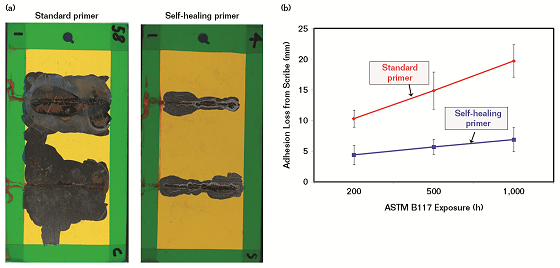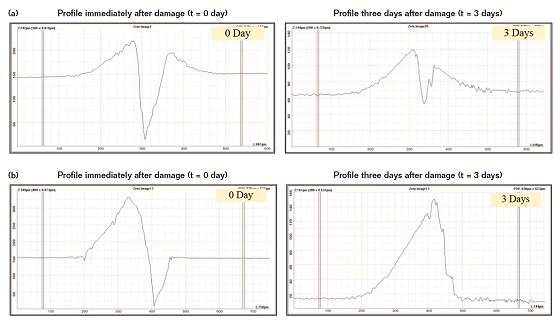Self-healing materials are a class of smart materials capable of autonomic repair after damage at ambient temperature without external intervention.1-2 Since White, et al.,3 reported the first example of self-healing polymeric material capable of autonomic repair without any external intervention, the concept of self-healing functionality has captured the imagination of academia and industry alike and spawned the development of various chemistries and concepts for designing self-healing functionality into polymeric materials.
These chemistries and concepts include autonomic options that do not require any external intervention,4-6 and non-autonomic options that might require heat or ultraviolet radiation, for example, to facilitate the healing response.7-8 Few applications have the potential to benefit more from the life extension that could be gained by incorporating self-healing functionality into protective coating systems than offshore oil and gas structures that face harsh corrosive environments paired with costly maintenance and downtime.
This article includes the first phase of the results of a collaboration between Chevron, a major oil and gas asset owner; Rust-Oleum, a manufacturer of a range of protection solutions for metal substrate; and Autonomic Materials, Inc., a supplier of microencapsulated self-healing agents. The primary goal of the study was to develop, validate, and deploy a self-healing coating system that would extend the life of standard protective coatings, resulting in reduced costs and labor associated with coating maintenance for offshore applications. The resulting coating systems were tested at a third-party laboratory, Charter Coating Services (2000), Ltd., in Calgary, Alberta, Canada.
The objective of the first phase of this study was to characterize the self-healing mechanism and the performance of METAPrime†, a commercially available self-healing coating, within the context of damage scales encountered in use cases for coatings used in oil and gas applications.
Smaller-scale damage was imparted into the coating system in an effort to simulate micro-cracking, which typically renders coating systems susceptible to moisture ingress. Moisture ingress is known to compromise adhesion of a coating to the underlying substrate and cause corrosion undercutting (creep), resulting in the need for maintenance.
Healing Mechanism
The self-healing additive evaluated is comprised of a liquid healing agent that contains polymer precursors based on epoxy, siloxane, and/or alkyd chemistries, encapsulated in microcapsules measuring 10 to 20 µm (0.4 to 0.8 mils) in diameter made of a polymeric shell wall. After manufacturing in an oil-in-water emulsion, the microcapsules are isolated via spray-drying. The microcapsules are then incorporated into the targeted coating formulation along with other dry pigments and other particulate additives.
The mechanism of restoring the coating’s protective capability depends on the type and scope of the damage. Micro-cracks are plugged by the polymerized healing agent, while the edges of larger-scale damage and cracks stemming from them are sealed. When a traditional coating is damaged, the underlying substrate is exposed and quickly corrodes. The corrosion propagates at the coating-substrate interface, leading to further delamination of the coating. Damage to a similar coating incorporating microcapsule-based self-healing functionality ruptures the microcapsules releasing the healing agent into the site of damage. Once polymerized in the site of damage, the healing agent seals the edge of the damage.4-6
Formulation Optimization and Initial Testing
To create the self-healing, high-performance coating evaluated, the formulation of a commercially available epoxy was adjusted to incorporate the self-healing additive. A schematic showing a comparison between the standard primer and the version incorporating the self-healing additive is provided in Figure 1. For initial performance evaluations, the standard primer and the self-healing version were applied to cold-rolled steel substrates in two coats with a combined 200 µm (8 mils) dry film thickness (DFT), followed by the topcoat.

The systems evaluated included five disparate topcoats, including acrylic, alkyd, acrylic-urethane, polyester-urethane, and epoxy chemistries. After allowing a minimum of seven days for curing following application of the topcoats, two parallel scribes, with <50 mm (2 in) between them, were made on the coated substrates using a 500-µm scribe tool. The resulting samples were then allowed to equilibrate at room temperature for 24 h prior to starting salt fog exposure (ASTM B1179). A representative pair of images showing the performance of the self-healing coating relative to the standard analogue is shown in Figure 2(a) and a summary of the average coating adhesion loss from the scribe after 1,000 h of salt fog exposure for each of the five systems evaluated is shown in Figure 2(b).
Compared to the control systems, the systems incorporating the self-healing functionality exhibited a minimum of a 50% improvement in adhesion around the scribed areas.

Characterization of the Healing Mechanism
To validate the self-healing technology in a protective coating system in extremely corrosive environments, a testing protocol using multiple analytical methods to further elucidate the healing mechanism of the system was designed. In these experiments, for the control and self-healing systems, abrasive-blasted steel substrates were coated with two coats of the epoxy at roughly 100 µm (4 mils) DFT each, followed by a polyurethane (PUR) topcoat applied at roughly 50 µm (2 mils) DFT. To simulate smaller-scale damage in the coating system, such as micro-cracking, a commercially available double-edged blade with a sharp tip and a thickness of ~635 µm (25 mils) was used to damage the coating system by scribing each coated sample down to the underlying substrate.
The samples were then immediately exposed to a salt fog and evaluated daily to photographically document the kinetics of corrosion on the substrate. The scribe defects on the test samples were also characterized using optical profilometry, scanning electron microscopy (SEM)/energy dispersive spectroscopy (EDX), and elemental mapping. The results obtained after three days of salt fog exposure are summarized in the following paragraphs.
In the case of the control, the initial width and depth at the area selected for analysis were 91 and 129 µm (3.6 and 5.2 mils), respectively. The formation of corrosion products was evident within the scribe after one day of salt fog exposure. After three days of salt fog exposure, the scribe width was observed to decrease by 40% to 55 µm (2.2 mils), while the depth was observed to decrease to 12 µm (0.48 mils) (Figure 3[a]). The change in the scribe width was likely due to some movement by the flexible epoxy resin binder while exposed to the slightly elevated temperature (35 °C) of the salt fog. The change in the scribe depth for the control sample appears to be largely due to corrosion products forming within the scribe. EDX analysis of the scribe immediately after damage exhibited a strong iron (Fe) signal resulting from the exposed substrate and corrosion products could be observed in the scribe by SEM.
In the case of the self-healing coating system, the initial width and depth at the areas evaluated were 124 and 144 µm, respectively. No formation of corrosion products within the scribe was evident after one day of salt fog exposure. After three days of salt fog exposure, some iron oxide staining of the coating along the scribe line was observed. The scribe width was observed to decrease by 54% to 57 µm (2.3 mils), while the depth was observed to decrease by 98% to 3 µm (0.12 mils) (Figure 3[b]). It should be noted that the changes in the scribe dimensions are significantly greater relative to the control (compare Figures 3[a] to [b]).

Furthermore, although EDX analysis of the scribe immediately after damage exhibited a strong Fe signal resulting from the exposed substrate, after three days of salt fog exposure, SEM analysis showed a distinct morphology change within the scribe that was inconsistent with the morphology characterized as corrosion in the control. EDX and elemental mapping analysis showed no significant deposition or formation of corrosion products within the scribe. Instead, a uniform distribution of salt deposit was observed on one edge of the scribe, likely trapped by polymerized healing agent, preventing it from reaching the substrate.
Technology Applications and Value
There is a substantial benefit to extending the life of coatings for offshore and onshore applications. In a recent report,10 NACE International assessed the global annual cost of corrosion to be $2.5 trillion, which is equivalent to 3.4% of the global GDP (2013). The study further estimated that savings of up to 35% could be realized on the actual costs of corrosion-related maintenance (not including lost revenue due to downtime) over the life of an asset by simply implementing available corrosion control methods. NACE has also estimated the total cost of marine corrosion worldwide to be between $50 to 80 billion every year.
A separate analysis based on data published in a previously referenced NACE article11 has shown that increasing the paint service life by as little as 25% (e.g., from 12 to 15 years) could lead to a cost savings of 32.7%.12 Note that the preliminary data reported here (Figure 2) suggests the potential of a far greater increase in service life as the performance of the self-healing coating after 1,000 h of salt fog exposure exceeds that of the control at 250 h. In addition to offshore applications, onshore assets exposed to harsh corrosive environments can also benefit from extending coating life. Although the cost to send maintenance crews to onshore sites is less drastic than offshore, there are still cost savings to be had with the reduction of coating upkeep necessitated by corrosion.
Technology Validation and Conclusions
This investigation has proven that after inflicting scribe damage to the coatings, the self-healing system incorporated into them releases a healing agent that forms a barrier at the site of damage, resulting in depth reduction of the scribe that significantly surpasses the damage response of the control system (compare Figures 3[a] and [b]).
Although the self-healing process occurred within the first three days of salt fog exposure, it resulted in a maintenance of adhesion of the coating to the substrate after damage and germane protection of the substrate that led to a 65% decrease in the amount of corrosion creep observed after 1,000 h of ASTM B117 exposure (Figure 2[b]). The focus of ongoing studies is to assess the robustness of this coating system by conducting a range of cyclic aging resistance tests specified by the oil and gas industry for offshore topsides qualification.
Overall, the results discussed in this article suggest that self-healing additives can be used to improve the performance of a coating system that is subject to mechanical damage, micro-cracking, and subsequent corrosion of the substrate while in service. While future work will further develop our understanding of the limitations and functionality afforded by the incorporation of self-healing additives into offshore protective coatings, what we have accomplished so far suggests that coatings exhibiting this kind of damage repair can significantly reduce maintenance costs by optimizing service life and reducing asset downtime.
† Trade name.
References and Author Biographies